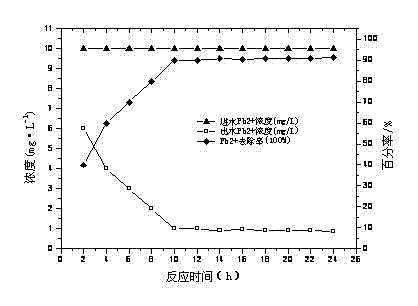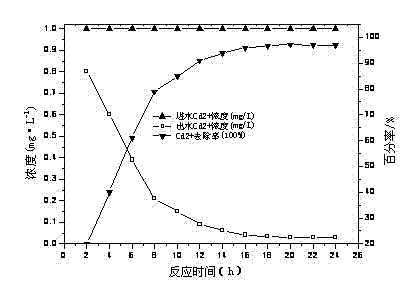Radiation preparation method and application of polymer hydrogel-based nano iron oxide
A nano-iron oxide and hydrogel-based technology, which is applied in chemical instruments and methods, other chemical processes, water/sewage treatment, etc., can solve the problems of decreased purity and function of polymer materials, and can increase the adsorption effect and facilitate The effect of simple operation and preparation method
- Summary
- Abstract
- Description
- Claims
- Application Information
AI Technical Summary
Problems solved by technology
Method used
Image
Examples
Embodiment 1
[0028] 1. Take a certain volume of hydroxyethyl acrylate monomer (referred to as HEA) as component A, weigh a certain mass of N-vinylimidazole (referred to as NVI) and dissolve it in deionized water, fully dissolve and mix it uniformly as component B, and Component B is added to component A and mixed well; distilled water is used as component C and mixed according to (A+B):C ratio of 3:7 (v / v), where A:B ratio is 5:2 (mol / mol). The mixture was treated with ultrasound to homogenize the mixture.
[0029] 2. After nitrogen filling, at a temperature of -78°C, the radiation dose range is controlled within 1×10 4 ~1×10 8 Gy, using high-energy rays ( 60 Co-γ-ray) irradiation polymerization to form polymer hydrogels.
[0030] 3. Cut the polymer hydrogel formed after irradiation into small pieces of 1cm×1cm×1cm, put them in the Erlenmeyer flask for multiple times of washing, and then dry them at 40°C.
[0031] 4. Weigh an appropriate amount of polymer hydrogel to be modified and ...
Embodiment 2
[0036] 1. Take a certain volume of hydroxyethyl acrylate monomer (referred to as HEA) as component A, weigh a certain mass of N-vinylimidazole (referred to as NVI) and dissolve it in deionized water, fully dissolve and mix it uniformly as component B, and Component B is added to component A and mixed well; distilled water is used as component C and mixed according to (A+B):C ratio of 2:5 (v / v), where A:B ratio is 5:2 (mol / mol). The mixture was treated with ultrasound to homogenize the mixture.
[0037] 2. After nitrogen filling, at a temperature of -78°C, the radiation dose range is controlled within 1×10 4 ~1×10 8 Gy, using high-energy rays ( 137 Cs-γ-ray) irradiation polymerization to form polymer hydrogels.
[0038] 3. Cut the irradiated polymer hydrogel into small pieces of 1cm×1cm×1cm, put them in the Erlenmeyer flask for multiple times of washing, and then dry them at 40°C.
[0039] 4. Weigh 10g of the polymer hydrogel to be modified and put it into a three-necked ...
Embodiment 3
[0044] 1. Take a certain volume of hydroxyethyl acrylate monomer (referred to as HEA) as component A, weigh a certain mass of N-vinylimidazole (referred to as NVI) and dissolve it in deionized water, fully dissolve and mix it uniformly as component B, and Component B is added to component A and mixed well; distilled water is used as component C and mixed according to (A+B):C ratio of 3:7 (v / v), where A:B ratio is 5:2 (mol / mol). The mixture was treated with ultrasound to homogenize the mixture.
[0045] 2. After nitrogen filling, at a temperature of -95°C, the radiation dose range is controlled within 1×10 4 ~1×10 8 Gy, using high-energy rays ( 60 Co-γ-ray) irradiation polymerization to form polymer hydrogels.
[0046] 3. Cut the irradiated polymer hydrogel into small pieces of 1cm×1cm×1cm, put them in the Erlenmeyer flask for multiple times of washing, and then dry them at 40°C.
[0047] 4. Weigh 10g of the polymer hydrogel to be modified and put it into a three-neck bot...
PUM
| Property | Measurement | Unit |
|---|---|---|
| adsorption capacity | aaaaa | aaaaa |
| adsorption capacity | aaaaa | aaaaa |
| adsorption capacity | aaaaa | aaaaa |
Abstract
Description
Claims
Application Information
 Login to View More
Login to View More - R&D
- Intellectual Property
- Life Sciences
- Materials
- Tech Scout
- Unparalleled Data Quality
- Higher Quality Content
- 60% Fewer Hallucinations
Browse by: Latest US Patents, China's latest patents, Technical Efficacy Thesaurus, Application Domain, Technology Topic, Popular Technical Reports.
© 2025 PatSnap. All rights reserved.Legal|Privacy policy|Modern Slavery Act Transparency Statement|Sitemap|About US| Contact US: help@patsnap.com



